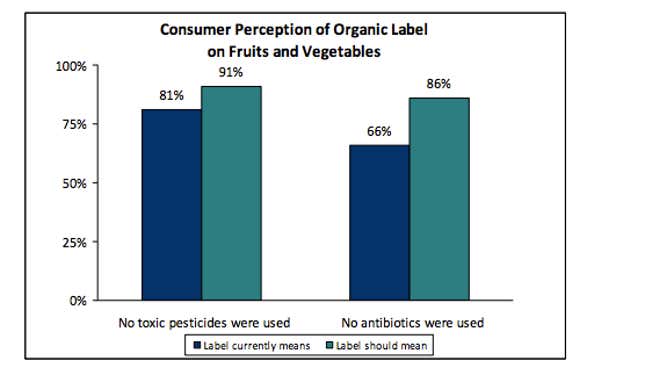When US shoppers buy organic, they’re usually confused about what they’re getting. A new survey (pdf) by the Consumer Reports National Research Center finds that 84% of US adults sometimes buy organic-labeled food (and 45% buy it once a month or more.) But the majority of survey respondents were unclear on what these labels actually mean.
A primer, for US shoppers: If a product says “100% Organic,” it must contain only non-synthetic ingredients. But a “Certified Organic” label means that 95% or more of the ingredients present have to be free of all synthetic additives (like pesticides and dyes) and the other 5% need to come from an approved list of not-quite-natural ingredients and additives. If you don’t see the “USDA Organic” seal, the product probably contains an even larger percentage of synthetic ingredients.
When surveyed, 81% of shoppers thought that a certified organic label meant no toxic pesticides at all were used, and 61% thought that no antibiotics were used in the raising and processing of organic products. But this isn’t always the case: In fact, while federal law prohibits synthetic pesticides, fertilizers, antibiotics, growth hormones, and artificial ingredients, exemptions can be granted that last for five years at a time. And since 2013, the US Department of Agriculture’s National Organic Program has allowed exempt material—that is, synthetic substances that have been given special permission to remain in certified organic food—to be re-approved indefinitely without public notification.

That’s quite contrary to what US shoppers are looking for in their organic purchases: 91% and 86% of those surveyed said that organic food shouldn’t use pesticides or antibiotics, respectively. “The public does not want a host of artificial ingredients in their organic food,” Dr. Urvashi Rangan, executive director of Consumer Reports Food Safety and Sustainability Center, told Food Safety News, but “some national advisers and decision-makers in the National Organic Program have overtly expressed a desire to grow the exemption list in order to grow the organic market.”
While organic food sales continue to increase in the US—even less high-end stores like Wal-Mart are in on the trend—shoppers certainly aren’t clear on what they’re being sold. The survey also found that 20% of respondents were under the impression that they’d bought “organic” fish—though the USDA has yet to approve standards for such a certification.
